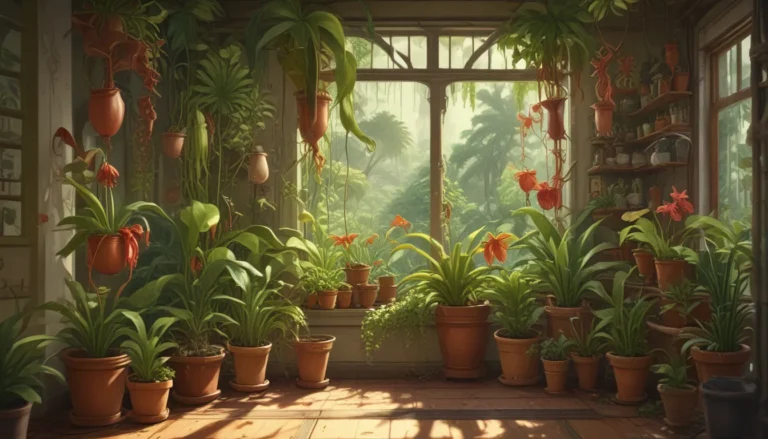Complete Guide to Growing and Caring for Rattlesnake Plants

Are you looking to add a touch of tropical allure to your indoor garden? Look no further than the stunning rattlesnake plant, also known as Goeppertia insignis or Calathea insignis. With its long, glossy leaves and striking dark green splotches, this plant is sure to captivate your heart.
In this comprehensive guide, we’ll cover everything you need to know about growing and caring for rattlesnake plants. Whether you’re a seasoned prayer plant collector or a newbie looking to expand your houseplant collection, we’ve got you covered. So let’s dive in and explore the world of this captivating species!
What You’ll Learn
Here’s what we’ll cover in this guide:
- What Is a Rattlesnake Plant?
- Cultivation and History
- Propagation
- How to Grow
- Growing Tips
- Pruning and Maintenance
- Where to Buy
- Managing Pests and Disease
- Best Uses
- Quick Reference Growing Guide
While we’ll focus primarily on the rattlesnake plant in this article, we encourage you to check out our complete guide for more general care guidance for prayer plants.
What Is a Rattlesnake Plant?
Rattlesnake plant, or Goeppertia insignis, is a tropical, evergreen, herbaceous perennial native to the State of Rio de Janeiro in southeast Brazil. It belongs to the Marantaceae family and shares its lineage with beauties such as Stromanthe thalia ‘Triostar’ and peacock plant.
Characterized by its long, lance-shaped leaves with distinctive dark green splotches, this plant has a reptilian allure that is hard to resist. Its fountain-like growth habit and unique leaf movements in response to light and darkness make it a fascinating addition to any indoor garden.
Cultivation and History
Originally classified in the Calathea genus, G. insignis and its calathea relatives were taxonomically reclassified to a different genus, Goeppertia, in 2012. Despite this name change, the species is still commonly referred to as Calathea insignis in both gardening circles and scientific communities.
Goeppertia insignis thrives in dappled shade in humid tropical forests as an understory plant. With its nontoxic nature, it’s a safe choice for homes with pets and children. While primarily used as a houseplant, this species can also be grown outdoors year-round in USDA Hardiness Zones 10a to 12.
Propagation
Propagation of rattlesnake calatheas is best done through division, as calathea seeds are hard to source and challenging to propagate. To propagate your plant, look for new leaves unfurling in late winter or early spring and divide the plant into several clumps with at least three leaves each. Repot the clumps in separate pots to encourage healthy growth.
How to Grow Rattlesnake Plants
To ensure your rattlesnake plant thrives, it’s essential to provide it with the right growing conditions. Here are some key tips to keep in mind:
Choosing a Plant
Select a healthy specimen with no signs of wilting, yellowing, disease, or pests. Avoid plants with evident issues and opt for robust, vibrant specimens.
Light
Place your rattlesnake plant in medium, indirect light to mimic its natural habitat in shady tropical forests. Avoid direct sun exposure, especially during midday and afternoon, as it can cause leaf scorching and loss of patterns.
Temperature
Maintain a moderate temperature between 65 and 75°F for optimal growth. Protect your plant from cold drafts and hot air to prevent stress and damage.
Water
Water your plant regularly to keep the soil moist but not soggy. Use distilled or filtered water to avoid impurities that can harm your plant. Consider bottom watering for a more efficient watering routine.
Humidity
Rattlesnake plants thrive in humid environments with a relative humidity of at least 50 percent. Use humidity trays, group plants together, or use a humidifier to maintain ideal humidity levels.
Soil
Choose a peaty, well-draining potting mix without perlite to ensure proper water retention and drainage. Aim for a pH between 6.1 and 7.3, and consider adding compost, biochar, and humic acid for optimal growth.
Growing Tips
To summarize, here are some essential tips for growing healthy rattlesnake plants:
- Provide medium, indirect light.
- Maintain moist but not soggy soil with good drainage.
- Avoid drafts and temperature extremes.
Pruning and Maintenance
While rattlesnake calatheas are relatively low-maintenance, here are some tips to keep your plant healthy and attractive:
Pruning
Trim off brown or damaged leaves as needed to improve the overall appearance of your plant. Use sterilized scissors to make clean cuts and promote new growth.
Fertilizing
Use a gentle fertilizer like worm compost tea to nourish your plant without causing nutrient imbalances. Follow the manufacturer’s instructions for optimal results.
Cleaning Leaves
Regularly wipe down your plant’s leaves with a damp cloth to remove dust and debris that can clog its stomata and hinder its growth.
Repotting
Repot your rattlesnake plant every two to three years in spring or when you notice signs of overcrowding or moisture retention in the soil. Choose a slightly larger pot, refresh the growing medium, and water thoroughly after repotting.
Where to Buy Rattlesnake Plants
When purchasing a rattlesnake plant, consider the size that best suits your space and preferences:
Small
For terrariums or small spaces, opt for a small starter plant in a three- or four-inch pot.
Medium
Medium-sized plants in six-inch pots are ideal for creating a statement on side tables or desks.
Large
For floor specimens, choose a mature plant in an eight-inch pot to make a bold statement in your space.
Managing Pests and Disease
While rattlesnake calatheas are generally resilient to pests and diseases, it’s essential to monitor for common issues like mealybugs, scale insects, and spider mites. Prevent diseases like cucumber mosaic virus and root rot by maintaining good hygiene and watering practices.
Best Uses
Rattlesnake plants are perfect for ornamental purposes, adding a touch of tropical charm to any indoor space. Use them as focal points, grouped with other foliage plants, or in interiorscaping projects. Their nontoxic nature also makes them safe for homes with children and pets.
Conclusion
By following these comprehensive guidelines, you’ll be well-equipped to grow and care for your rattlesnake plants successfully. Whether you’re a seasoned gardener or a beginner, these tips and recommendations will help you create a thriving indoor garden filled with the unique beauty of Calathea insignis. Share your experiences and tips in the comments to help fellow plant enthusiasts cultivate healthy and vibrant rattlesnake plants in their homes. Happy gardening!





